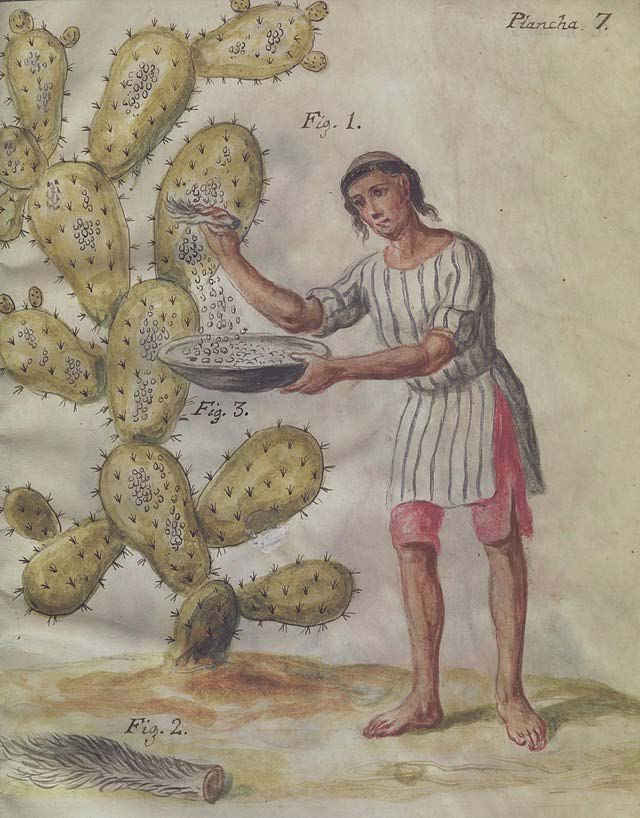Seeing Red
Today we are "Seeing RED". The University of Houston presents this series about the machines that make our civilization run, and the people whose ingenuity created them.
Has your head ever swiveled towards a perky red beret or does a saucy scarlet lipstick catch your eye? Red is more than a color - it goes to the very heart of us. The iron that gives our blood its vivid hue also colors the sediments of our red planetary neighbor Mars. Iron ore pigments have been used through the millennia in the Paleolithic caves of Lascaux, France; The Neanderthals also used red ochre as found on a 50,000 year old painted shell.

Egyptian clam shell paint holder Photo Credit: Ancient History Encyclopedia
Throughout time, as our survival depended on foraging ripe fruits, red may have been the first universal color recognized as such. Ancient Egyptians used it to adorn themselves with cosmetics. Romans preferred lavish fire-red vermilion on the walls of their noble villas.

Roman fresco Villa dei Misteri Pompeii Photo Credit: Ancient History Encyclopedia
After Imperial Purple, royalty and the Christian clergy adopted red, produced with root-based madder. Following the conquest of the Aztec kingdom, the Spaniards saw a dye being given in tribute by the indigenous peoples: cochineal, produced by female cactus lice. It is still used today: the next time you bite into a luscious red velvet cupcake, you can thank the species: Dactylopius coccus.

Indian gathers cochineal, Jose Antonio de Alzate y Ramirez, 1777 Photo Credit: Ancient History Encyclopedia
Red is found in the taxonomy of species from the chipper red cardinal to the robin red-breast. The term "rufous" describes distinctive red feathers or fur, such as the Rufous Hummingbird, or the Rufous Hare. In people, red hair is notorious, going back as far as Eric the Red, King Henry VIII of England, and his successor daughter Elizabeth I, known for her fiery red hair and her marked use of elaborate red gowns to project her power. Although natural red hair is rare, the ubiquity of henna attests to its magnetism.

Elizabeth I in Parliament Robes Photo Credit: Ancient History Encyclopedia
Culturally, red has a larger meaning: it may point towards a fallen nature as in the "Scarlet Letter", or red-light districts. At the same time it is the color of romantic love. In China and India it is the color of traditional bridal dresses representing loyalty and fertility. The fairytale "Little Red Riding Hood" infuses the rosy garment with talismanic meaning. Linguistically, red implies anger, as in "Seeing Red". Edgar Allen Poe viscerally titled one of his stories, "The Masque of the Red Death".
Red has played a prominent role in Technicolor film, beginning with Dorothy's ruby slippers that took her home. In Alfred Hitchcock's thriller "Marnie" a red screen signals Marnie's descent into a psychotic trance. Red is also dominant when used in physical environments, signage and logos. Whether through dreams or desires its special nature elicits strong responses.

Dorothy's shoes Photo Credit: Ancient History Encyclopedia
Red, the color that pervades all cultures, from rituals to food to fashion, and represents the duality of love and hate, life and death, lives deep in our psyches.
I'm Celeste Williams for the University of Houston where we're interested in the way inventive minds work.
(Theme music)
Pastoureau, Michel, Red, The History of a Color, Princeton University Press, Princeton and Oxford, Princeton, NJ, 2017.
St. Clair, Kassia, The Secret Lives of Colour, Penguin Random House, London, 2017.
Perryman, Laura, The Color Bible, the Definitive Guide for Artists and Designers, Prestel Press, Munich, London, New York, 2021.
Harvey, Jacky Collins, Red: A History of the Redhead, Black Dog and Leventhal Press, New York, 2015.
Adams, Sean, The Designer's Dictionary of Color, Abrams Publishers, New York, 2017.
https://www.npr.org/templates/story/story.php?storyId=122466430 accessed 03/22/22.